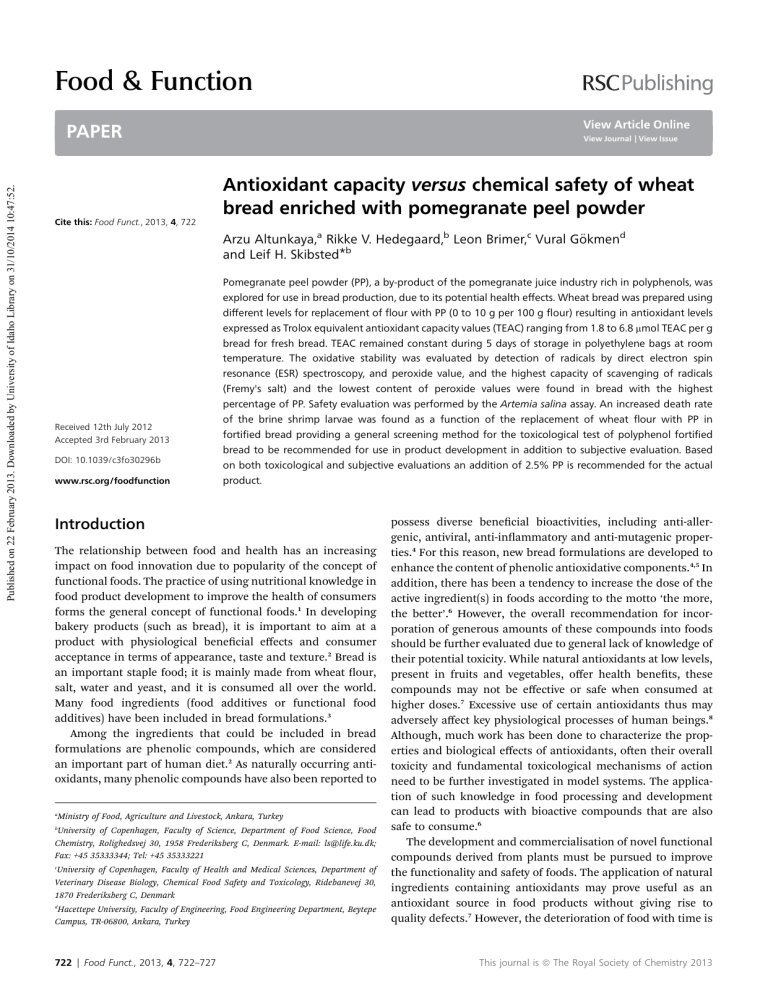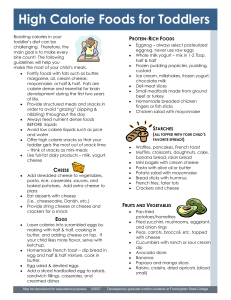
Food & Function View Article Online Published on 22 February 2013. Downloaded by University of Idaho Library on 31/10/2014 10:47:52. PAPER View Journal | View Issue Antioxidant capacity versus chemical safety of wheat bread enriched with pomegranate peel powder Cite this: Food Funct., 2013, 4, 722 Arzu Altunkaya,a Rikke V. Hedegaard,b Leon Brimer,c Vural Gökmend and Leif H. Skibsted*b Pomegranate peel powder (PP), a by-product of the pomegranate juice industry rich in polyphenols, was explored for use in bread production, due to its potential health effects. Wheat bread was prepared using different levels for replacement of flour with PP (0 to 10 g per 100 g flour) resulting in antioxidant levels expressed as Trolox equivalent antioxidant capacity values (TEAC) ranging from 1.8 to 6.8 mmol TEAC per g bread for fresh bread. TEAC remained constant during 5 days of storage in polyethylene bags at room temperature. The oxidative stability was evaluated by detection of radicals by direct electron spin resonance (ESR) spectroscopy, and peroxide value, and the highest capacity of scavenging of radicals (Fremy's salt) and the lowest content of peroxide values were found in bread with the highest percentage of PP. Safety evaluation was performed by the Artemia salina assay. An increased death rate Received 12th July 2012 Accepted 3rd February 2013 of the brine shrimp larvae was found as a function of the replacement of wheat flour with PP in fortified bread providing a general screening method for the toxicological test of polyphenol fortified bread to be recommended for use in product development in addition to subjective evaluation. Based DOI: 10.1039/c3fo30296b on both toxicological and subjective evaluations an addition of 2.5% PP is recommended for the actual www.rsc.org/foodfunction product. Introduction The relationship between food and health has an increasing impact on food innovation due to popularity of the concept of functional foods. The practice of using nutritional knowledge in food product development to improve the health of consumers forms the general concept of functional foods.1 In developing bakery products (such as bread), it is important to aim at a product with physiological benecial effects and consumer acceptance in terms of appearance, taste and texture.2 Bread is an important staple food; it is mainly made from wheat our, salt, water and yeast, and it is consumed all over the world. Many food ingredients (food additives or functional food additives) have been included in bread formulations.3 Among the ingredients that could be included in bread formulations are phenolic compounds, which are considered an important part of human diet.2 As naturally occurring antioxidants, many phenolic compounds have also been reported to a Ministry of Food, Agriculture and Livestock, Ankara, Turkey b University of Copenhagen, Faculty of Science, Department of Food Science, Food Chemistry, Rolighedsvej 30, 1958 Frederiksberg C, Denmark. E-mail: [email protected]; Fax: +45 35333344; Tel: +45 35333221 c University of Copenhagen, Faculty of Health and Medical Sciences, Department of Veterinary Disease Biology, Chemical Food Safety and Toxicology, Ridebanevej 30, 1870 Frederiksberg C, Denmark d Hacettepe University, Faculty of Engineering, Food Engineering Department, Beytepe Campus, TR-06800, Ankara, Turkey 722 | Food Funct., 2013, 4, 722–727 possess diverse benecial bioactivities, including anti-allergenic, antiviral, anti-inammatory and anti-mutagenic properties.4 For this reason, new bread formulations are developed to enhance the content of phenolic antioxidative components.4,5 In addition, there has been a tendency to increase the dose of the active ingredient(s) in foods according to the motto ‘the more, the better’.6 However, the overall recommendation for incorporation of generous amounts of these compounds into foods should be further evaluated due to general lack of knowledge of their potential toxicity. While natural antioxidants at low levels, present in fruits and vegetables, offer health benets, these compounds may not be effective or safe when consumed at higher doses.7 Excessive use of certain antioxidants thus may adversely affect key physiological processes of human beings.8 Although, much work has been done to characterize the properties and biological effects of antioxidants, oen their overall toxicity and fundamental toxicological mechanisms of action need to be further investigated in model systems. The application of such knowledge in food processing and development can lead to products with bioactive compounds that are also safe to consume.6 The development and commercialisation of novel functional compounds derived from plants must be pursued to improve the functionality and safety of foods. The application of natural ingredients containing antioxidants may prove useful as an antioxidant source in food products without giving rise to quality defects.7 However, the deterioration of food with time is This journal is ª The Royal Society of Chemistry 2013 View Article Online Published on 22 February 2013. Downloaded by University of Idaho Library on 31/10/2014 10:47:52. Paper Food & Function inevitable and from a chemical point of view, oxygen is directly involved in food deterioration.9 Bread's oxidative stability is strongly affected by temperature, presence of oxygen, light and lipolytic enzymes.10 Therefore, characterization of the early oxidative changes occurring during storage should be valuable for understanding quality changes in bread and may even provide a tool for shelf life prediction of new bread products including products added plant derived antioxidants. Industrialization of the bread production necessitates development of products with a high degree of product stability in order to provide the required extended shelf life.10 The present study investigates the effect of adding naturally occurring antioxidants derived from pomegranate [Punica granatum L. (Punicaceae)] fruit peel powder to bread, monitoring the effects on safety and quality of bread. Pomegranate fruit peel is a by-product of the pomegranate juice industry and contains predominantly hydrolysable tannin belonging to ellagitannins.11 The quality of the bread was evaluated, by measurement of indicators of oxidative changes and by sensory proling of the bread, during storage up to 5 days. Oxidative changes were followed by the use of ESR spectroscopy, analysis of lipid hydroperoxides by determination of peroxide value and determination of overall antioxidative capacity by TEAC, whereas the chemical safety of enriched bread was estimated by the Artemia salina toxicity assay. Results and discussion Comparison of bread color between the control and bread with three levels of PP is found in Table 1. In the present study, PP was nely ground and with a darker color than the our. Therefore, bread with PP was expected to have a different color compared to the control. Spectrophotometric measurement showed a consistent trend in bread color. With increasing levels of PP addition, L* values decreased, while a* and b* values increased, showing that PP affected bread color. These observations were indicative of a loss in brightness of the bread caused by PP. The L*, a* and b* values were found signicantly different between the control and the bread with PP at all three levels ( p < 0.05). Table 1 Colorimetric parameters of different bread samples during 0, 2 and 5 days of storage. Results are expressed as means SD for n ¼ 6, p < 0.05 Pomegranate peel L* a* b* Table 2 Subjective evaluation of pomegranate peel powder incorporated breads. Numbers with different letters are significantly different from each other Substitute level (%) Color 0 2.5 5.0 10.0 5.3 6.4 6.6 5.8 1.7a 1.6a 1.6a 1.8a Texture 5.7 6.4 6.1 5.1 1.7a 1.6a 1.9a 1.1a Aroma 5.4 5.9 5.3 5.0 1.9a 1.6a 1.7a 2.0a Taste 5.6 5.9 5.7 3.6 1.6a 1.3a 1.9a 1.4b Mouth feel 5.3 6.7 5.7 4.4 1.3a 1.7a 1.7a 1.6a Table 2 presents the results obtained in the subjective evaluation of acceptance (color, texture, aroma, taste and mouth feel) of the control and the PP enriched bread samples conducted with 10 untrained panelists. All samples when evaluated with respect to color had acceptability scores ranging from neither like nor dislike (5) to like slightly (6–7). The bread with 5.0% PP had the highest color scores showing acceptability values of 6.6 1.6 whereas minimum scores were given to the bread prepared from unfortied ours with acceptability values of 5.3 1.7. It was possible to observe that increasing the level of PP caused an increase in darkness. The mean scores for texture and aroma acceptance ranged from again neither like nor dislike to like slightly. The statistical analysis showed that the control bread did not differ from the 2.5–10.0% PP enriched bread in the sensory attributes of texture and aroma ( p < 0.05). Regarding taste and mouth feel acceptance, all averages were between dislike slightly and like slightly. Moreover, only 10% PP enriched bread differed statistically from the control bread and the bread enriched with other 2 ratios in taste scores ( p < 0.05). The sensory test results suggested that addition of PP in bread formulations would not in general interfere with bread acceptability, in fact the sample with 2.5% PP supplementation had a good subjective (>5) regarding both color and texture, as well as aroma, taste and mouth feel. The results of a triangle test using bread with different substitution levels of PP are shown in Table 3. It was concluded that bread fortication with 2.5% or 5.0% PP did not signicantly change the avor, taste or general appearance of bread (Table 2). Only 30% of panelists successfully identied the bread fortied with 2.5% or 5.0% PP. However, bread fortied with 2.5 or 5.0% PP was successfully differentiated from the 10.0% PP fortied and non-fortied bread samples. Visual evaluation of color change was consistent with the results from colorimetric analysis. Nevertheless, 60% of the Replacement level Storage time (days) Control 2.5% 5.0% 10.0% 0 2 5 0 2 5 0 2 5 54.8 54.4 55.3 3.5 3.6 3.6 17.3 17.4 17.6 48.0 0.2 48.2 0.3 48.4 0.3 5.0 0.1 4.8 0.1 4.9 0.1 17.9 0.1 17.7 0.1 17.8 0.1 43.6 0.3 44.0 0.4 43.2 0.4 6.5 0.2 6.3 0.3 6.5 0.5 19.0 0.2 18.9 0.3 19.0 0.3 37.8 0.1 38.3 0.1 38.2 0.1 6.9 0.1 6.7 0.1 6.9 0.1 20.3 0.1 20.2 0.1 20.3 0.1 0.1 0.3 0.2 0.2 0.1 0.1 0.1 0.1 0.2 This journal is ª The Royal Society of Chemistry 2013 Table 3 Test of difference for white wheat bread due to substitution with pomegranate peel powder (PP: pomegranate peel)a Total number Number of Signicance Treatment comparison of panelists correct answers of difference Control vs. 2.5% PP Control vs. 5.0% PP 2.5% PP vs. 5.0% PP 2.5% PP vs. 10.0% PP 5.0% PP vs. 10.0% PP a 10 10 10 10 10 9 8 3 7 7 * * N.S. * * *: signicant, N.S.: not signicant. Food Funct., 2013, 4, 722–727 | 723 View Article Online Published on 22 February 2013. Downloaded by University of Idaho Library on 31/10/2014 10:47:52. Food & Function panelists liked the color of PP fortied bread better in all ratios than that of the control bread. The oxidative stability of the wheat bread investigated was evaluated by measuring, peroxide value, overall antioxidant capacity using Trolox equivalent antioxidant capacity assays and radical detection with direct electron spin resonance spectroscopy in order to give a more comprehensive characterization. It was clearly demonstrated that oxidative changes occur in bread during storage. The measurement of lipid hydroperoxides was performed to follow the progress in primary oxidation products. There were signicant changes in peroxide values with addition of PP (p < 0.05). Furthermore, a substantially lower level of hydroperoxides was found in bread enriched with 10% PP compared to the bread enriched with two other ratios and the control (0.22–0.30 mE H2O2 per g of bread for control bread and bread enriched with 2.5–5.0% PP compared to 0.12–0.14 mE H2O2 per g of bread for bread enriched with 10.0% PP). The concentration of lipid peroxides increased signicantly in all the bread samples during storage for 5 days (p < 0.05), as shown in Fig. 1. Similar results were obtained in a study performed by Jensen et al.,10 who found an increase in the concentration of hydroperoxides for whole wheat bread and for whole wheat bread enriched with rosemary extracts. The antioxidative capacity of the soluble constituents in the bread was also evaluated by the TEAC assay during storage. This assay measures the ability to quench free radicals and is indicative of the oxidative resistance of the tested samples. From Fig. 2 it was obvious that a higher level of PP in the bread resulted in a higher antioxidant activity of the corresponding bread sample. Similar results were obtained by Peng et al.,4 where increasing levels of grape seed extract enhanced the antioxidant capacity of wheat bread. Moreover, a decrease in the antioxidative capacity as a consequence of storage was seen in all of the bread samples and reects a progress in the oxidative reactions, which leads to depletions of the antioxidants.10 The radical scavenging capacities of breads with different levels of PP were evaluated by studying the reduction of the stable radical, Fremy's salt. The scavenging of Fremy's salt was monitored by ESR. Diamagnetic (compounds with an even Fig. 1 Concentration of hydroperoxide equivalents of bread samples with and without addition of various concentrations of pomegranate peel measured by Trolox equivalent antioxidant capacity ( : control; : 2.5% pomegranate peel; : 5% pomegranate peel; : 10% pomegranate peel). 724 | Food Funct., 2013, 4, 722–727 Paper Fig. 2 Overall oxidative capacity of bread samples with and without addition of various concentrations of pomegranate peel measured by Trolox equivalent antioxidant capacity (TEAC) ( : control; : 2.5% pomegranate peel; : 5% pomegranate peel; : 10% pomegranate peel). number of electrons) reduction products are formed, when antioxidative compounds react with Fremy's salt, leading to a decrease in the intensity of the ESR signal.12 Therefore, addition of higher levels of PP led to a decrease in the ESR signal for Fremy's salt during storage (Fig. 3). Nevertheless, the results also showed that storage signicantly increased the radical scavenging capacity of the bread samples (p < 0.05) due to the progress in oxidative reactions. Bread has a relatively high oxidative stability due to the balance between oxidative and antioxidative compounds in the bread. In the current experiment, the bread samples were stored in polyethylene bags at room temperature corresponding to the storage conditions of commercially available bread. TEAC assay was found to provide valuable information on the antioxidative capacity in bread together with ESR spectroscopy as these techniques detected changes in the oxidative stability aer 5 days of storage. The peroxide value also measured the progress in oxidation. TEAC and ESR assays measure scavenging of free radicals by electron transfer from the potential antioxidant to free radical molecules and are relevant assays for the prediction of the oxidative stability of a given food during storage. Based on the results obtained from peroxide value analysis and by the TEAC and ESR assays, it was apparent that antioxidant activity increases with the increasing amount of PP. Fig. 3 Relative content of free radicals in bread samples with and without addition of various concentrations of pomegranate peel measured by direct electron spin resonance spectroscopy and given as peak heights ( : control; : 2.5% pomegranate peel; : 5% pomegranate peel; : 10% pomegranate peel). This journal is ª The Royal Society of Chemistry 2013 View Article Online Published on 22 February 2013. Downloaded by University of Idaho Library on 31/10/2014 10:47:52. Paper Fig. 4 Food & Function Death rate of Artemia salina for extracts of bread samples. The Artemia salina (brine shrimp) test was performed to get a rst impression of whether the addition of PP could be detected in a simple generalized toxicity test using extracts of the nal bread products. Larvae death rates found for the dry and reconstituted extracts of the different PP fortied breads are shown in Fig. 4. Indeed a slight concentration dependent increase of death rates was found as a function of an increase in the concentration of PP in the bread. Thus, the bread samples enriched with different levels of PP exhibited signicantly different death rates in brine shrimp (except for 5.0% vs. 10.0%, p < 0.05). Experimental Chemicals 6-Hydroxy-2,5,7,8-tetramethylchroman-2-carboxylic acid (Trolox), 2,20 -azinobis-(3-ethylbenzothiazoline)-6-sulfonic acid (ABTS), methanol, ethanol, chloroform, hexane, acetone, ammonium thiocyanate, iron(III) chloride hexahydrate, ammonium persulphate, potassium bromide, potassium chloride, aluminum oxide and hydrochloric acid were all from SigmaAldrich (Steinheim, Germany). Barium chloride, iron(II) sulphate, sodium chloride, calcium chloride dihydrate, sodium bicarbonate, magnesium chloride hexahydrate, sodium sulphate, acetic acid and hydrogen peroxide (30%) were from Merck (Darmstadt, Germany). Water was puried through Millipore Q-plus purication train (Millipore Corp., Bedford, MA, USA). Preparation of stripped walnut oil The method described by Yoshida13 was modied to remove the antioxidants from walnut oil by column chromatography using alumina. Rened oil (100 mL) was passed through a column containing activated aluminum oxide (140 g) dried at 200 C for 8 h before use. The column was wrapped in aluminum foil to avoid oxidation. The oil was drawn through the column by suction. The oil collected was again passed through fresh alumina (140 g) for complete removal of the antioxidants. The oil was analyzed by HPLC to conrm the total removal of tocopherols and stored at 18 C until use. Preparation of bread Wheat bread (total weight of 750 g) was prepared on a bread machine (Philips HD 6020, Germany) using the recipe: walnut This journal is ª The Royal Society of Chemistry 2013 oil (stripped – 1½ tablespoon about 15 g), Milli Q water (280 mL), salt (1¼ teaspoon about 6.26 g), stone milled our obtained from a local miller (Aurion, Denmark) (455 g) and dry yeast (3/4 teaspoon about 2.25 g). Except for the our the other ingredients were obtained commercially from a local market in Copenhagen, Denmark. Dried pomegranate peels, purchased from a local market in Ankara, Turkey, were powdered in a grinder to get 40 mesh size powders. Wheat bread was prepared using different levels for replacement of our with PP (0, 2.5, 5.0 and 10.0 g per 100 g our). Program 1 for basic white bread (750 g per each) was chosen for bread making. Briey, this programme adopts the following sequential processes; rst kneading (18 min), rest (25 min), second kneading (16 min), rst rising (46 min), third kneading (30 s), second rising (25 min), fourth kneading (15 s), third rising (55 min) and baking (50 min at 110 C). All breads were prepared in two batches. Aer 1 h of cooling, the breads were sliced (slices of a thickness of approximately 1.5 cm) carefully. Bread crusts were carefully sliced off and the crumbs were used for color measurement. Aerwards, the crumbs were dried in an oven at 30 C for 16 h and ground for later analysis. Color measurement Using a CM-3500d spectrophotometer (Minolta, Japan), color intensity of the two central slices of each bread was measured and expressed as L*, a* and b* values against a known white background. In color intensity determinations, L* represented whiteness (value 100) or blackness (value 0), a* represented red (+a) or green (a), and b* represented yellow (+b) or blue (b). Subjective evaluation of bread samples The subjective evaluation was carried out on the bread samples within 24 h of baking. The sensory panel group consisted of ten panelists in the Food Science Department. The samples (control and 2.5%, 5.0% and 10.0% PP fortied breads) were sliced into equally sized pieces (1.5 cm thick) and served in dishes labeled randomly with codes. The samples were evaluated by 10 untrained panelists (laboratory personnel and students) using the hedonic scaling method (9–1 scoring): 1 ¼ extremely dislike (or lowest quality), 5 ¼ neither like nor dislike (or medium quality), and 9 ¼ extremely like (or highest quality), respectively. Internal and external characteristics of appearance of texture, color, aroma, taste, and mouth feel were determined and rated on a score sheet by attributes. Water was provided for rinsing purposes. A triangle test was also performed for the subjective evaluation of PP fortied bread in a full factorial design. One level of PP enriched bread and one from another level were offered. Subjects were asked to choose the sample which was unlike the other two. Peroxide value Lipid hydroperoxides were analysed as described by Oestdal et al.14 with some modications. Three solutions were prepared prior to analysis. Solution 1 was made by mixing 0.4 g of barium chloride dihydrate in 50 mL of Milli Q water with 0.50 g of FeSO4$7H2O in 50 mL of Milli Q water followed by ltration. The Food Funct., 2013, 4, 722–727 | 725 View Article Online Published on 22 February 2013. Downloaded by University of Idaho Library on 31/10/2014 10:47:52. Food & Function ltrate was added 2 mL of HCl (10 M). Solution 2 was prepared by adding 3 g of ammonium thiocyanate in 10 mL of Milli Q water. Solution 3 was a methanol : chloroform (1 : 1, v/v) solution. A nal iron(II)–thiocyanate solution was prepared by mixing solutions 1, 2, and 3 in the ratio 1 : 1 : 98, v/v. Sample extracts were prepared by mixing 1 g of bread crumbs in 5 mL of Milli Q water and 10 mL of solution 3. Subsequently, the extract was vortexed for 30 s and centrifuged for 10 min (1.3 103 g). The lower phase was transferred to a test tube and mixed with 1 ml of iron(II)–thiocyanate solution. Aer exactly 5 min the absorbance was measured at a wavelength of 500 nm with pure chloroform as the blank using a spectrophotometer (HP 8453). The concentration of lipid hydroperoxides was expressed as hydrogen peroxide equivalents using a standard curve. Antioxidant activity measurement 100 mg ground bread powders were dispersed into 80% ethanol (1 mL) and vortexed (5 s). The samples were extracted by sonication for 30 min and aerwards centrifuged (3233g) for 20 min, and the supernatant was collected as the ethanol extract. Total antioxidant capacity was determined using the Trolox equivalent antioxidant activity (TEAC) assay according to Miller and RiceEvans15 with minor modications. Briey, 7 mM ABTS_+ salt solution was reacted with 2.45 mM potassium peroxodisulphate solution and the reaction mixture was le in the dark for 16 h at room temperature (25 C). The resultant radical solution was diluted with Milli Q water to an absorbance of 0.7 0.05 at 734 nm. Fiy microliters of bread extract solution or standard (different concentrations of Trolox) were added to 1.95 mL of diluted ABTS_+ solution and absorbance was taken at 734 nm on a UV spectrophotometer (HP 8453) aer 7 min incubation. Results were expressed as TEAC values (mmol Trolox per g bread). Reduction of Fremy's salt radical The antioxidative effect of PP fortied breads was determined as their ability to reduce the stable radical Fremy's salt as measured by electron spin resonance (ESR). Ethanolic extracts of PP fortied breads (described above) were mixed with 200 mL of a solution of Fremy's salt (820 mM) in 25% saturated sodium carbonate solution. The mixture was le for 5 min before an ESR spectrum was recorded on an ESR Miniscope MS 100 (Magnettech, Berlin, Germany). The measurements were carried out at room temperature. The instrument settings were as follows: centre eld, 3366.90 G; sweep width, 30 G; sweep time, 30; modulation amplitude, 1.0 G and microwave power, 10 mW. Soware analyses (Magnettech, Berlin, Germany) were employed to obtain the areas under the ESR spectra by double integration. Artemia salina toxicity assay For this purpose, the test setup described by Sam16 was used with some modications. Ethanolic extracts of PP fortied breads (described above) were evaporated to dryness in a vacuum rotary evaporator (T ¼ 45 C). Thus, the bread extracts were evaluated in a test for lethality to brine shrimp larvae as performed in microliter plates. Toxicities of samples were tested at 100 and 1000 ppm in articial sea water solutions with 100 mL 726 | Food Funct., 2013, 4, 722–727 Paper being added to 100 mL of a suspension of larvae holding approximately 10 larvae. A parallel series of tests with standard potassium dichromate solution (0–1600 ppm) and the blank control were always conducted to ensure the correct function of the assay. The concentration giving rise to a mortality of 50% (LC50) aer 20 h of exposure was determined for the standard curve using the Reed–Muench method.17 Two hundred mg of Artemia salina cysts (eggs) were incubated under light in a Petri dish with 25 mL articial sea water, at a temperature in the interval between 25 and 28 C. Articial sea water consisted of 24 g NaCl, 1.5 g CaCl2$2H2O, 0.1 g KBr, 0,7 g KCl, 0.2 g NaHCO3, 11 g MgCl2$6H2O, 4 g Na2SO4 in 1000 mL distilled water. Aer 24 h, the content of the Petri dish was poured into a test tube. Nauplii (rst stage brine shrimp larvae) were separated from the eggs by pipetting them into a small beaker. A suspension of 10–15 organisms (in 100 mL) was added to each well. Then, the standard solutions or different concentrations of the bread extracts (100 mL) were added into the wells of the microliter plates and covered with a sealing membrane (number of wells: 354). Plates were incubated in the dark at 25 C for 20 h. Plates were then examined under a magnier and the number of dead (non-mobile) nauplii in each well were counted. 100 mL of sulphuric acid were then added to each well and aer 15 min the total numbers of shrimp larvae in each well were counted. On this basis the death rates in percentage were calculated. The number of dead nauplii was plotted against potassium dichromate concentration and the semi-logarithmic regression curve was established (y ¼ 12.721ln(x) 10.629; r2 ¼ 0.99). Statistical analysis Duplicate analyses were performed and results were averaged. The data were subjected to ANOVA test for the evaluation of statistical signicance of the differences between mean values by Duncan's test and the levels of signicance were set at 95%. Conclusion Addition of PP powder at different percentages (0% to 10%) to wheat bread enhanced the sensory quality and total antioxidant capacity of bread. The bread with the highest amount of PP (10%) showed the highest antioxidative activity and the lowest value of L* regarding the crumb color. 2.5% PP supplementation had a good acceptance in the subjective evaluation (>5) of color, aroma, texture, taste and mouth feel whereas 10% supplementation scored the lowest. The analysis of the antioxidative capacity also showed that the relatively small changes in antioxidative capacity during storage depended on the amount of PP included in the bread recipe. In the evaluation of chemical safety, an increase in the larvae death rate was found as a function of concentration in PP fortied bread, demonstrating that toxic/physiological effects depending on the addition of the plant product can be detected investigating the nal bread product. In conclusion it is important to choose the appropriate amount of PP to obtain healthy baked goods without promoting any possible negative effects on sensorial characteristics of bread. This journal is ª The Royal Society of Chemistry 2013 View Article Online Paper Published on 22 February 2013. Downloaded by University of Idaho Library on 31/10/2014 10:47:52. References 1 D. Peressini and A. Sensidoni, J. Cereal Sci., 2009, 2, 190–201. 2 F. Balestra, E. Cocci, G. Pinnavaia and S. Romani, LWT -Food Sci. Technol., 2011, 44, 700–705. 3 L. Fan, S. Zhang, L. Yu and L. Ma, Food Chem., 2006, 101, 1158–1163. 4 X. Peng, J. Ma, K. Cheng, Y. Jiang, F. Chen and M. Wang, Food Chem., 2010, 119, 49–53. 5 S. Jensen, H. Oestdal, L. H. Skibsted and A. K. Thybo, J. Cereal Sci., 2011a, 53, 291–297. 6 A. Bast and G. R. M. M. Haenen, Environ. Toxicol. Chem., 2002, 11, 251–258. 7 R. H. Liu, Am. J. Clin. Nutr., 2003, 78, 517–520. 8 R. Blomhoff, Proceedings from a symposium held at The Norwegian Academy of Science and Letters, Oslo, 2008. 9 C. Penicaud, S. Peyron, N. Gontard and V. Guillard, Food Rev. Int., 2012, 28, 113–145. This journal is ª The Royal Society of Chemistry 2013 Food & Function 10 S. Jensen, H. Oestdal, M. R. Clausen, M. L. Andersen and L. H. Skibsted, LWT -Food Sci. Technol., 2011b, 44, 637– 642. 11 P. Panichayupakaranant, I. Atcharaporn and A. Sirikatitham, Pharm. Biol., 2010, 48, 201–205. 12 H. B. Graversen, E. M. Becker, M. L. Andersen and L. H. Skibsted, Eur. Food Res. Technol., 2006, 226, 737– 743. 13 H. Yoshida, J. Sci. Food Agric., 1993, 62, 41–47. 14 H. Oestdal, H. J. Andersen and J. H. Nielsen, J. Agric. Food Chem., 2000, 48, 5548–5556. 15 N. C. Miller and C. Rice-Evans, Food Chem., 1997, 60, 331– 337. 16 T. W. Sam, in Bioactive Natural Products, ed. S. M. Colegate and R. J. Molyneux, CRC Press, Boca Raton, 2nd edn, 1993, ch. 2, pp. 442–456. 17 L. J. Reed and H. Muench, Am. J. Hyg., 1938, 27, 493– 497. Food Funct., 2013, 4, 722–727 | 727









